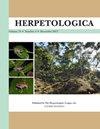Cutaneous Evaporative Water Loss in Lizards is Variable across Body Regions and Plastic in Response to Humidity
IF 1.1
3区 生物学
Q2 ZOOLOGY
引用次数: 0
Abstract
Abstract: As the climate crisis continues to alter temperature regimes and water availability, studying how animals regulate water balance grows in importance. We studied variation in water loss across the skin among body regions and its plasticity in response to humidity acclimation in Western Fence Lizards (Sceloporus occidentalis). We examined the effects of climatic and physiological variables on cutaneous evaporative water loss (CEWL) and compared CEWL rates among body regions (dorsum, ventrum, head, dewlap, and mite patch). The best model to explain baseline variation in log-transformed CEWL included: body region; lizard mass; ambient temperature, vapor pressure deficit (VPD), and solar radiation at the time of capture; body temperature, ambient temperature, and VPD at the time of CEWL measurement; and the interactions between body region and each of mass and VPD at the time of capture. These results demonstrate cutaneous osmoregulatory variability among lizards based on climate and body size and within individual lizards based on body region. We also tested CEWL plasticity in response to humidity acclimation. Lizards exposed to humid conditions for 8 d exhibited increased CEWL, and lizards exposed to dry conditions exhibited decreased CEWL compared to initial measurements. This is evidence for rapid and significant acclimatory responses of CEWL in response to changes in environmental humidity. Such variation and plasticity suggest that lizards possess a certain degree of ability for using osmoregulatory changes to respond to climate change.蜥蜴的皮肤蒸发水分损失因身体各部位和塑料对湿度的反应而变化
摘要:随着气候危机继续改变温度和水资源的可用性,研究动物如何调节水平衡变得越来越重要。我们研究了西部围栏蜥蜴(Sceloporus occidentalis)不同身体区域皮肤水分损失的变化及其对湿度适应的可塑性。我们研究了气候和生理变量对皮肤蒸发水分损失(CEWL)的影响,并比较了不同身体区域(背部、腹部、头部、露腹和螨斑)的CEWL发生率。解释对数变换CEWL基线变化的最佳模型包括:身体区域;蜥蜴群;捕获时的环境温度、蒸汽压不足(VPD)和太阳辐射;CEWL测量时的体温、环境温度和VPD;以及在捕获时身体区域与质量和VPD中的每一个之间的相互作用。这些结果表明,蜥蜴的皮肤渗透调节变异性取决于气候和体型,而个体蜥蜴则取决于身体区域。我们还测试了CEWL对湿度适应的可塑性。与最初的测量结果相比,暴露在潮湿条件下8天的蜥蜴表现出CEWL增加,而暴露在干燥条件下的蜥蜴表现出来的CEWL减少。这是CEWL对环境湿度变化做出快速而显著的适应反应的证据。这种变异和可塑性表明,蜥蜴具有一定程度的利用渗透调节变化来应对气候变化的能力。
本文章由计算机程序翻译,如有差异,请以英文原文为准。
求助全文
约1分钟内获得全文
求助全文
来源期刊

Herpetologica
生物-动物学
CiteScore
4.60
自引率
0.00%
发文量
27
审稿时长
>12 weeks
期刊介绍:
Established in 1936, Herpetologica is a quarterly peer-reviewed journal serving herpetologists, biologists, ecologists, conservationists, researchers and the scientific community. The journal contains original research papers and essays about the biology of reptiles and amphibians, and covers many relevant topics including: behavior, conservation, ecology, genetics, morphology, physiology and taxonomy.
 求助内容:
求助内容: 应助结果提醒方式:
应助结果提醒方式:


